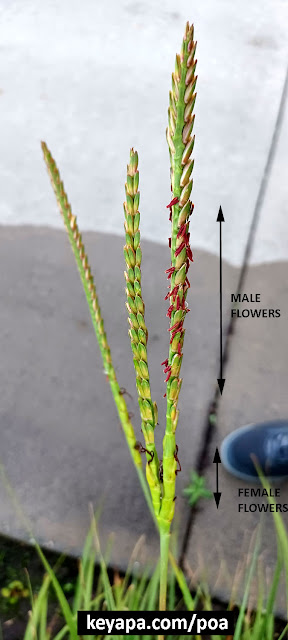I like taking macrophotographs of grass reproductive structures, and when I was taking some pics of the native ornamental Trypsacum dactyloides (Eastern Gamagrass) I noticed something different.
Grass flowers are notoriously tiny, and in fact the flowerheads that we see at the macro scale are aggregations of so-called "spikelets", which may contain one to many "florets" (the actual flowers).
 |
| Male (anther) and female (stigma) structures in Imperata cylindrica (cogon grass) |
All the florets that I had seen so far have been perfect, with each floret having both male and female parts.
The male part is the stamen, which is composed of a filament holding up an anther, where the pollen resides. The female part is the pistil, which contains an ovary, a style, and a stigma. The anther and the feathery stigma are what people usually see easily when doing macro of grass flowers.
 |
| Feathery stigma and anthers hanging from filaments in Phalaris arundinacea (Reed Canary Grass) |
The spikelets of T. dactyloides were surprising to me because at first glance I noticed that the male and female parts seem to be located on different parts, and thus different flowers!
Trypsacum dactyloides is a native grass here in Florida that is widely used as an ornamental, both in city street plantings, and in suburban areas. It is an attractive plant, with wide dark green leaves and a kinda roundish habit.
It turns out that this species, unlike many other grasses, is monoecious, with imperfect (or unisexual) flowers. Monoecious means that there are both male and female flowers on the same individual plant, and unisexual flowers have only either male or female parts.
 |
| Stigma of T. dactyloides |
In T. dactyloides, the male florets are situated on the upper part of the grass inflorescence, while the female flowers are located in the lower part of the same inflorescence. This is in contrast to bisexual flowers, which contain both male and female reproductive organs, and which I am more familiar with from my previous photos of other grasses.
 |
| Purplish anthers of T. dactyloides |



No comments:
Post a Comment